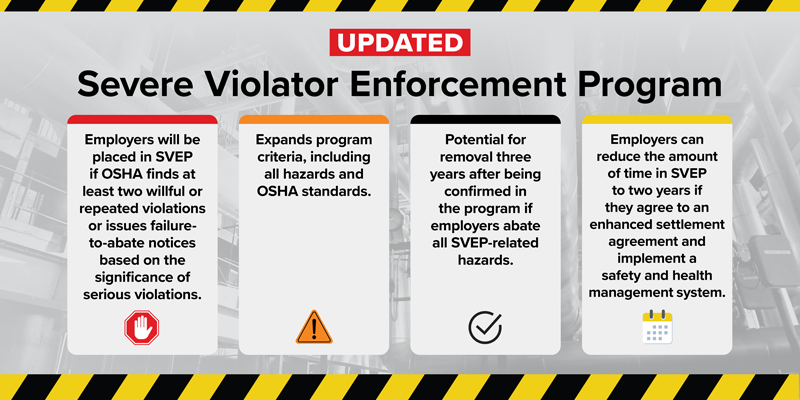
In October 2021, an employee of a Texas metal fabrication company was using a heat torch when oxygen leaked from a hose in poor condition, causing a fire flash in the El Paso facility. He suffered second-degree burns to his left hand.
In January 2022, another employee suffered an amputation injury because dangerous machinery lacked proper guards. Later the same month, we received a complaint alleging employees were forced to jump approximately 3 feet from a ladder onto a platform with no safety rails, exposing them to a potentially deadly fall.
After a total of 10 incidents in 5 years, including five repeat machine guarding violations, the company met the criteria for the Severe Violator Enforcement Program, or SVEP. First introduced in June 2010, the program concentrates OSHA’s resources on inspecting employers like this one who continue to expose workers to very serious dangers, even after being cited for them.
It is critical that OSHA uses all the tools it has available to protect workers when an employer repeatedly disregards their health and safety. This week, we’re making some important updates to the SVEP program to help ensure we are doing just that:
- The expanded program criteria now includes all hazards and OSHA standards. The old criteria was limited to cases involving fatalities, three or more hospitalizations, high-emphasis hazards, the potential release of a highly hazardous chemical (process safety management), and enforcement actions classified as egregious.
- Employers will be placed in the program if OSHA finds at least two willful or repeated violations or issues failure-to-abate notices based on the presence of high gravity serious violations. Under the old criteria, the focus was on cases where a willful or repeated serious violation, or there was a hazard the employer failed to abate, that was directly related to either an employee death or an incident that caused three or more hospitalizations.
- Follow-up or referral inspections must be conducted within one year, but not longer than two years, after the final order. Previously, there was no required time frame in which OSHA would conduct a follow-up inspection after the final order.
- The potential for removal from the program begins three years after the date of verification that all SVEP-related hazards have been abated, instead of when final order is issued. A final order and meeting other conditions are still required for removal from SVEP, but the clock for potential removal starts when the employer fixes the hazard instead of at the end of a highly variable administrative process.
- Employers can reduce the amount of time in SVEP to two years if they consent to an enhanced settlement agreement that involves implementing a safety and health management system. The system must include the seven basic elements outlined in OSHA’s Recommended Practices for Safety and Health Programs. Previously, employers were only eligible for removal from SVEP after three years. These last two changes incentivize employers to fix problems quickly and develop lasting solutions to change their health and safety culture.
It is the goal of this administration to maximize all tools available to us to ensure employers comply with their legal obligation to provide safe and healthful workplaces. These changes to SVEP will hold a microscope to those employers who continue to expose workers to very serious dangers and help ensure America’s workers come home safe at the end of every shift. And we will continue to review and improve our enhanced enforcement programs and procedures to ensure we are fully implementing our authority under the OSH Act.
Learn more about the Severe Violator Enforcement Program at osha.gov/enforcement/svep.
Doug Parker is the assistant secretary of labor for occupational safety and health. Follow OSHA on Twitter at @OSHA_DOL.

 U.S. Department of Labor Blog
U.S. Department of Labor Blog
